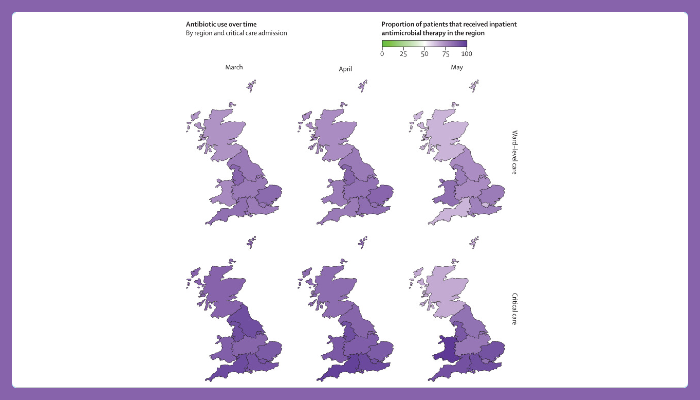Use of antibiotics in Covid-19 treatment could be reduced
Published: 7 June 2021
The high use of antibiotics in patients hospitalised with COVID-19 is often not necessary and risks worsening global antimicrobial resistance, according to new research led by the Centre for Virus Research.

The high use of antibiotics in patients hospitalised with COVID-19 is often not necessary and risks worsening global antimicrobial resistance, according to new research led by the Centre for Virus Research (CVR).
Published in The Lancet Microbe, the study was conducted in collaboration with the universities of Edinburgh and Liverpool and Imperial College London as part of the ISARIC (International Severe Acute Respiratory and emerging Infections Consortium) WHO Clinical Characterisation Protocol UK (CCP-UK).
Researchers found that antibiotic use was very high in hospitalised COVID-19 patients in the UK during the first wave of the virus despite confirmed bacterial infection being uncommon.
Overall, 85 per cent of patients received one or more antibiotics during their hospital admission, with the highest use in critical care, while 37 per cent of patients were prescribed antibiotics prior to admission.
There was high use of broad-spectrum antibiotics – those active against a very wide range of bacteria – and evidence that this could be reduced by using more targeted but equally appropriate alternatives.
Importantly, confirmed bacterial infections in people with COVID-19 were uncommon, especially when first admitted to hospital, so a more restrictive approach to using antibiotics would be safe and should be encouraged.
Most of the bacteria identified represented secondary infections that began more than 48 hours from admission.
Researchers also found that secondary infections occurring after hospitalisation were not specific to COVID-19 infection and were more in keeping with hospital-associated infections and particularly those infections typically seen in intensive care units.
These findings will help to inform most appropriate approach to antibiotic prescribing in patients with COVID-19 suspected of having a bacterial infection.
Although co-infections were rarely observed during the first wave of the pandemic, there remains a need to monitor hospitalised patients in light of increased use of steroids and other COVID-19 treatments, which may increase susceptibility to bacterial infection.
However, the researchers argue that over-prescription of antibiotics and, particularly broad-spectrum antibiotics, in the majority of hospitalised patients with COVID-19 raises significant concern regarding the potential detrimental impact on antimicrobial resistance globally.
The importance of efforts to safely reduce and control antibiotic prescribing in COVID-19 should not be underestimated.
Dr Antonia Ho, Consultant in Infectious Diseases at the CVR and lead author of the study, said: “Until now, a detailed understanding of the nature of bacterial co-infections identified in patients with COVID-19, and the frequency and types of antibiotics these patients have been prescribed has been lacking.
"This study demonstrates the very high antibiotic use we see in hospitalised COVID-19 patients may not be necessary; indeed, it may actually contribute to antimicrobial resistance.
“While some COVID-19 patients will require antibiotics, mostly for secondary infections which develop after admission to hospital, our data shows that not all COVID-19 patients should be prescribed antibiotics.
"The longer someone is in hospital, particularly if they are in critical care, the more vulnerable they are to develop secondary infections, and these should continue to be monitored. However, the bugs we identified are similar to those found in patients with hospital-acquired infection, and not specific to COVID-19.”
Dr Clark Russell, a Clinical Lecturer at the University of Edinburgh said: “Bacterial chest and bloodstream infections are uncommon complications of COVID-19. This work identifies which bacteria tend to cause these infections when they do occur, helping clinicians to make a more informed choice about the best antibiotics to give people when needed.”
Professor Calum Semple, study co-lead said, “We only have safe surgery and medical cures for many life threatening conditions because antibiotics were discovered and mostly still work.
"Overuse of antibiotics needs to be avoided to prevent emergence of resistance. When the current threat from COVID-19 subsides, the problem of antimicrobial resistance will remain a threat.”
Bacterial co-infections and secondary infections are commonly identified in severe influenza - up to a quarter of cases - and other severe respiratory viral infections, where they are also associated with increased morbidity and mortality.
Current national and international COVID-19 guidelines vary in their recommendations on non-targeted antibiotic use.
UK guidelines advise against antibiotic use when the respiratory tract infection is thought to be due to COVID-19, without specific evidence of bacterial infection.
Co-infections, secondary infections, and antimicrobial usage in hospitalised patients with COVID-19 during the first wave from the ISARIC WHO CCP-UK study: a prospective, multicentre cohort study
- Clark D Russell, Cameron J Fairfield, Thomas M Drake, Lance Turtle, R Andrew Seaton, Dan G Wootton, Louise Sigfrid, Prof Ewen M Harrison, Annemarie B Docherty, Thushan I de Silva, Conor Egan, Riinu Pius, Hayley E Hardwick, Laura Merson, Michelle Girvan, Jake Dunning, Prof Jonathan S Nguyen-Van-Tam, Prof Peter J M Openshaw, J Kenneth Baillie, Prof Malcolm G Semple, Antonia Ho.
Funding: The work was funded by The Medical Research Council (MRC), National Institute for Health Research (NIHR) and by the NIHR Health Protection Research Unit (HPRU), Wellcome, and the Bill and Melinda Gates Foundation.
Image legend: Figure 4 Geographical variation in antimicrobial use over time
Enquiries: ali.howard@glasgow.ac.uk or elizabeth.mcmeekin@glasgow.ac.uk / 0141 330 6557 or 0141 330 4831
First published: 7 June 2021

